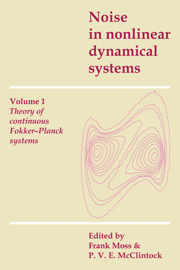Book contents
- Frontmatter
- Contents
- List of contributors
- Preface
- Introduction to Volume 1
- 1 Noise-activated escape from metastable states: an historical view
- 2 Some Markov methods in the theory of stochastic processes in nonlinear dynamical systems
- 3 Langevin equations with colored noise
- 4 First passage time problems for non-Markovian processes
- 5 The projection approach to the Fokker–Planck equation: applications to phenomenological stochastic equations with colored noises
- 6 Methods for solving Fokker–Planck equations with applications to bistable and periodic potentials
- 7 Macroscopic potentials, bifurcations and noise in dissipative systems
- 8 Transition phenomena in multidimensional systems – models of evolution
- 9 Colored noise in continuous dynamical systems: a functional calculus approach
- Appendix: On the statistical treatment of dynamical systems
- Index
1 - Noise-activated escape from metastable states: an historical view
Published online by Cambridge University Press: 05 January 2012
- Frontmatter
- Contents
- List of contributors
- Preface
- Introduction to Volume 1
- 1 Noise-activated escape from metastable states: an historical view
- 2 Some Markov methods in the theory of stochastic processes in nonlinear dynamical systems
- 3 Langevin equations with colored noise
- 4 First passage time problems for non-Markovian processes
- 5 The projection approach to the Fokker–Planck equation: applications to phenomenological stochastic equations with colored noises
- 6 Methods for solving Fokker–Planck equations with applications to bistable and periodic potentials
- 7 Macroscopic potentials, bifurcations and noise in dissipative systems
- 8 Transition phenomena in multidimensional systems – models of evolution
- 9 Colored noise in continuous dynamical systems: a functional calculus approach
- Appendix: On the statistical treatment of dynamical systems
- Index
Summary
Historical comments by a participant in the field represent a personal viewpoint. They are not a detached and scholarly contribution to the history of science. The field of this volume, and the (hopefully) closely related field of this discussion, involves a number of ‘schools’, of varying degrees of distinctness, and I cannot represent them all in this brief discussion. The Brussels School associated with Ilya Prigogine is one example. Another group, which is much more loosely knit and less clearly identifiable, can be associated with the work and influence of the late Elliott Montroll. This work comes closer to my viewpoint, represented below, but has had public visibility through recent books and conferences (Montroll and Lebowitz, 1979; Shlesinger and Weiss, 1985; Weiss, 1983, 1986). Both of the aforementioned ‘schools’ have a close relationship to physical chemistry, and we will, later in our discussion, return to some of the pioneering (but long neglected) insights which arose in this area. On the other hand, our field has equally deep, or perhaps deeper, roots in electronics. We will take it upon ourselves to represent that heritage. The approach we will stress describes some degrees of freedom and their dynamics explicitly; the remaining degrees of freedom are regarded as a source of noise and of damping. It is a viewpoint which has wide applicability, but is particularly directly and accurately applicable to electrical circuits.
- Type
- Chapter
- Information
- Noise in Nonlinear Dynamical Systems , pp. 1 - 15Publisher: Cambridge University PressPrint publication year: 1989
- 4
- Cited by



